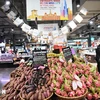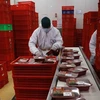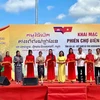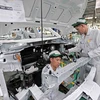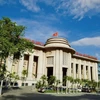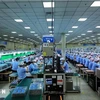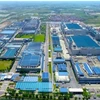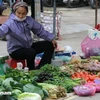Vietnam is striving towards producing one million tonnes of fresh milk from a total milk cow herd of 500,000 between now and 2020, according to the Ministry of Agriculture and Rural Development’s Animal Husbandry Department.
So far, 200,000 dairy cows are being raised in Vietnam , up from only 41,240 in the year 2000. Although milk production has increased sevenfold at 456,000 tonnes today compared to 2001, the total production only meets 28 percent of national demand. Last year, nearly 1.1 billion USD was spent on importing milk from abroad.
Cows are now predominantly reared in Hanoi; Ho Chi Minh City; the northern provinces of Son La, Tuyen Quang, Vinh Phuc; the central province of Nghe An; and the southern provinces of Long An, Lam Dong and Tay Ninh.
Dairy producers such as TH, Moc Chau and Vinamilk are modernising and their production and distribution technology.
With a milk output of 5.1 tonnes per lactation cycle Vietnam ranks highly in Southeast Asia, compared to Thailand with 3.2 tonnes, Indonesia with 3.1 tonnes and China with 3.4 tonnes.
Hanoi aims to meet 35 percent of the local demand by 2020 through the designation of 15 key dairy production areas in the outlying districts of Ba Vi, Gia Lam, Quoc Oai, Dong Anh, Dan Phuong and Phuc Tho.
Last year, Vinamilk, the country’s largest dairy producer, generated a record 230 million USD from exports to 11 countries and territories across the globe, said deputy head of the Animal Husbandry Department Tong Xuan Chinh.
According to the Vinh Phuc provincial Department of Agriculture and Rural Development, rearing cows has enhanced the livelihoods of thousands of farmers.
In the northern province of Tuyen Quang, the majority of cows are imported from Australia . Thanks to standardised farming techniques, farmers have doubled their milk output compared to 2009.
To secure fodder for 5,000 dairy cows by 2020, Tuyen Quang will expand the area of land used to produce fodder to 310ha in Yen Son and Yen Duong districts.
A representative from the Ho Chi Minh City Department of Agriculture and Rural Development said the ministry needs to develop a master plan for the dairy sector, including infrastructure improvements and a national programme on increasing the quality of dairy cows.
Nguyen Van Khoi, Deputy Director of the Soc Trang provincial Department of Agriculture and Rural Development, proposed the State facilitate dairy cow rearing in rural areas and areas inhabited by ethnic minorities, where land and workforce resources are abundant.-Vietnam is striving towards producing one million tonnes of fresh milk from a total milk cow herd of 500,000 between now and 2020, according to the Ministry of Agriculture and Rural Development’s Animal Husbandry Department.
So far, 200,000 dairy cows are being raised in Vietnam , up from only 41,240 in the year 2000. Although milk production has increased sevenfold at 456,000 tonnes today compared to 2001, the total production only meets 28 percent of national demand. Last year, nearly 1.1 billion USD was spent on importing milk from abroad.
Cows are now predominantly reared in Hanoi; Ho Chi Minh City; the northern provinces of Son La, Tuyen Quang, Vinh Phuc; the central province of Nghe An; and the southern provinces of Long An, Lam Dong and Tay Ninh.
Dairy producers such as TH, Moc Chau and Vinamilk are modernising and their production and distribution technology.
With a milk output of 5.1 tonnes per lactation cycle Vietnam ranks highly in Southeast Asia, compared to Thailand with 3.2 tonnes, Indonesia with 3.1 tonnes and China with 3.4 tonnes.
Hanoi aims to meet 35 percent of the local demand by 2020 through the designation of 15 key dairy production areas in the outlying districts of Ba Vi, Gia Lam, Quoc Oai, Dong Anh, Dan Phuong and Phuc Tho.
Last year, Vinamilk, the country’s largest dairy producer, generated a record 230 million USD from exports to 11 countries and territories across the globe, said deputy head of the Animal Husbandry Department Tong Xuan Chinh.
According to the Vinh Phuc provincial Department of Agriculture and Rural Development, rearing cows has enhanced the livelihoods of thousands of farmers.
In the northern province of Tuyen Quang, the majority of cows are imported from Australia . Thanks to standardised farming techniques, farmers have doubled their milk output compared to 2009.
To secure fodder for 5,000 dairy cows by 2020, Tuyen Quang will expand the area of land used to produce fodder to 310ha in Yen Son and Yen Duong districts.
A representative from the Ho Chi Minh City Department of Agriculture and Rural Development said the ministry needs to develop a master plan for the dairy sector, including infrastructure improvements and a national programme on increasing the quality of dairy cows.
Nguyen Van Khoi, Deputy Director of the Soc Trang provincial Department of Agriculture and Rural Development, proposed the State facilitate dairy cow rearing in rural areas and areas inhabited by ethnic minorities, where land and workforce resources are abundant.-VNA
So far, 200,000 dairy cows are being raised in Vietnam , up from only 41,240 in the year 2000. Although milk production has increased sevenfold at 456,000 tonnes today compared to 2001, the total production only meets 28 percent of national demand. Last year, nearly 1.1 billion USD was spent on importing milk from abroad.
Cows are now predominantly reared in Hanoi; Ho Chi Minh City; the northern provinces of Son La, Tuyen Quang, Vinh Phuc; the central province of Nghe An; and the southern provinces of Long An, Lam Dong and Tay Ninh.
Dairy producers such as TH, Moc Chau and Vinamilk are modernising and their production and distribution technology.
With a milk output of 5.1 tonnes per lactation cycle Vietnam ranks highly in Southeast Asia, compared to Thailand with 3.2 tonnes, Indonesia with 3.1 tonnes and China with 3.4 tonnes.
Hanoi aims to meet 35 percent of the local demand by 2020 through the designation of 15 key dairy production areas in the outlying districts of Ba Vi, Gia Lam, Quoc Oai, Dong Anh, Dan Phuong and Phuc Tho.
Last year, Vinamilk, the country’s largest dairy producer, generated a record 230 million USD from exports to 11 countries and territories across the globe, said deputy head of the Animal Husbandry Department Tong Xuan Chinh.
According to the Vinh Phuc provincial Department of Agriculture and Rural Development, rearing cows has enhanced the livelihoods of thousands of farmers.
In the northern province of Tuyen Quang, the majority of cows are imported from Australia . Thanks to standardised farming techniques, farmers have doubled their milk output compared to 2009.
To secure fodder for 5,000 dairy cows by 2020, Tuyen Quang will expand the area of land used to produce fodder to 310ha in Yen Son and Yen Duong districts.
A representative from the Ho Chi Minh City Department of Agriculture and Rural Development said the ministry needs to develop a master plan for the dairy sector, including infrastructure improvements and a national programme on increasing the quality of dairy cows.
Nguyen Van Khoi, Deputy Director of the Soc Trang provincial Department of Agriculture and Rural Development, proposed the State facilitate dairy cow rearing in rural areas and areas inhabited by ethnic minorities, where land and workforce resources are abundant.-Vietnam is striving towards producing one million tonnes of fresh milk from a total milk cow herd of 500,000 between now and 2020, according to the Ministry of Agriculture and Rural Development’s Animal Husbandry Department.
So far, 200,000 dairy cows are being raised in Vietnam , up from only 41,240 in the year 2000. Although milk production has increased sevenfold at 456,000 tonnes today compared to 2001, the total production only meets 28 percent of national demand. Last year, nearly 1.1 billion USD was spent on importing milk from abroad.
Cows are now predominantly reared in Hanoi; Ho Chi Minh City; the northern provinces of Son La, Tuyen Quang, Vinh Phuc; the central province of Nghe An; and the southern provinces of Long An, Lam Dong and Tay Ninh.
Dairy producers such as TH, Moc Chau and Vinamilk are modernising and their production and distribution technology.
With a milk output of 5.1 tonnes per lactation cycle Vietnam ranks highly in Southeast Asia, compared to Thailand with 3.2 tonnes, Indonesia with 3.1 tonnes and China with 3.4 tonnes.
Hanoi aims to meet 35 percent of the local demand by 2020 through the designation of 15 key dairy production areas in the outlying districts of Ba Vi, Gia Lam, Quoc Oai, Dong Anh, Dan Phuong and Phuc Tho.
Last year, Vinamilk, the country’s largest dairy producer, generated a record 230 million USD from exports to 11 countries and territories across the globe, said deputy head of the Animal Husbandry Department Tong Xuan Chinh.
According to the Vinh Phuc provincial Department of Agriculture and Rural Development, rearing cows has enhanced the livelihoods of thousands of farmers.
In the northern province of Tuyen Quang, the majority of cows are imported from Australia . Thanks to standardised farming techniques, farmers have doubled their milk output compared to 2009.
To secure fodder for 5,000 dairy cows by 2020, Tuyen Quang will expand the area of land used to produce fodder to 310ha in Yen Son and Yen Duong districts.
A representative from the Ho Chi Minh City Department of Agriculture and Rural Development said the ministry needs to develop a master plan for the dairy sector, including infrastructure improvements and a national programme on increasing the quality of dairy cows.
Nguyen Van Khoi, Deputy Director of the Soc Trang provincial Department of Agriculture and Rural Development, proposed the State facilitate dairy cow rearing in rural areas and areas inhabited by ethnic minorities, where land and workforce resources are abundant.-VNA
